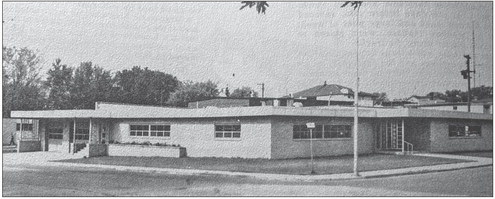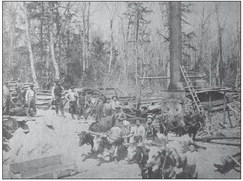A budding dairy industry hot spot


The City of Abbotsford has long been a hub of industry in central Wisconsin. Its many product manufacturers have a rich history within the city and have helped build it into what it is today. Before the industry arrived, Native American tribes occupied the land. The land mostly consisted of a dense forested area which included terrain and trees such as pine, hemlock, hardwood and swampland. The first settlers arrived in Abbotsford in 1873 after the Chippewa and Potowatomi Native Americans were relocated.
Abbotsford was settled by people from different nationalities. The contract to cut timber and clear the land for the village site was taken by S.A. Cook and Edwin H. Abbott made the first survey. The railroad was finished in October of 1873 and the first train was run into the village.
The village was later named Abbotsford after Edwin H. Abbot who was the president of the railroad at one time.
Early establishments were created to help facilitate the railroad. The roundhouse turntable and coal shoots were built in the late 1870s and large piles of wood, called woodup stations, were created to help fuel the trains. The roundhouse was a large building used for the repair of engines and the turntable was used for turning engines so they could go the opposite direction.
Additionally, a coal chute was a structure that was 80 feet high that allowed train cars loaded with coal to be pulled to the top and unloaded in a coal bin so the engines on the track under the bin could load up with coal.
The village of Abbotsford started to take off in terms of development in the early 1900s. After incorporating as a village in July of 1894, the population boomed to 362 people and the first elected president of the village became R.C. Tenant.
In the late 1890s, the village began creating a community as they built a village hall, a grade school and a number of churches. The logging industry brought many people to the City of Abbotsford as the heavily forested area provided a resource that was much needed for building and heating homes.
In 1909, the growth of the village was stunted after the Wisconsin Central railroad was sold to the St. Paul and Sault Ste. Marie, also known as the Soo Line Railroad Co.
The division pulled out and the area faced a mild depression. The value of property decreased and many homes were almost given away.
The depression only lasted a few years or until residents realized the agricultural potential in the area. The settlers then turned to farming and began to develop one of the most successful dairy sections in the country.
Cheese factories were often built four to five miles apart to help with transportation of milk and cheese as it was done by horse at the time. When it was possible to haul the milk by truck, most of the small, country factories quit business, although a few are still operating today, including Nasonville Dairy between Abbotsford and Curtiss.
The first milk plant established in the area was known as Wiggins Creamery and was established in 1900.
The boom of dairy industry allowed the village to build a new city hall in 1958 and become incorporated as a city in 1965.
The Soo Line still operated through Abbotsford, carrying passengers until 1958. The line was used for freight until around 2022 when the line was purchased by WATCO and has been dormant but not deemed abandoned as of yet.
The dairy success gradually brought more people to the region as they decided the area would be a good place to raise a family. The industrial and manufacturing opportunities came in the 1940s - 1970s with businesses like Melvin Companies (1932), Wisco Feeds (1932), Strek-O Doors (1940), Decorator Industries (1953), All Metal Stamping (1954), Abbotsford State Bank (1968), Creative Automation (1971), Abbyland Foods (1977) and Witmer Furniture (1981) choosing Abbotsford as their home.
The industrial growth has employed thousands of area workers and has instilled a hard-working mentality in central Wisconsinites.

EARLY INDUSTRY -This picture was taken in 1989 of the George Bushman sawmill crew. Oxen were used to transport lumber.DORCHESTER CENTENNIAL BOOK PHOTO
